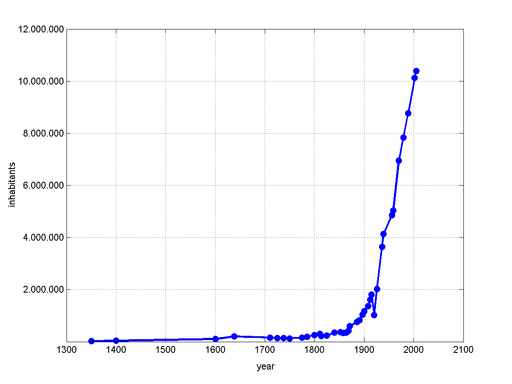Problems left Unsolved
Go directly to fullscreen view of the Neatline exhibit
When we first looked at our map of the main thoroughfares, waterways and green spaces planned for Moscow 1935, we saw it through the lens of Stalinism. The new general plan for reconstruction, designed by Vladimir Semenov and approved by Stalin and Molotov, fit nicely into our preconceived ideas about ideological, end-driven state-sponsored planning of the early Soviet era. The idea was to reconstruct a socialist city on the ruins of the old, medieval city, and if certain streets or neighborhoods had to be razed in order to create this new city, so be it. We saw violence in this plan, more sinister than Hausmannization of other cities because of its radical ideological cant.
However, after living for a few weeks with the thoroughfares, waterways, and green spaces planned for Moscow 1935, we have come to see this map very differently. Although the vision was indeed coordinated by Semenov and his partner Sergey Chernyshev within a socialist realist framework, it also pooled the work of an entire generation of avant-gardists, architects and urban planners, who participated through competitions and work in smaller ateliers under Semenov and Chernyshev. It contains many elements of this collective knowledge and experience, such as the ‘ensembles’ [also known as kvartaly or mikrorayon], city-block size structures that are designed to enhance communal life through shared amenities and unique identities. The strong emphasis on waterways and green spaces as necessary ‘breathing spaces’ built into the city reflect the legacy of nineteenth-century ideals about hygiene and industry. The primary crisis facing the city structure was the population explosion of new arrivals from the countryside.
Above all the goal was to decentralize, to expand the existing radial road system and enhance it with the metro without deepening the hierarchy between center and periphery.
These are challenges that speak to us far beyond the end of state socialism. This plan proposes several solutions for problems still left unsolved...
When we contrast the entirety of the 1935 plan for reconstructing Moscow with the most recent municipal vision for Moscow 2020, it is hard not to notice several important parallels. The recent expansion of the city limits to include its southwestern suburbs, the redevelopment of its industrial zones (which were never a part of the 1935 vision), the metro’s second ring...these are all responses to the pressure of a new population boom, and the decentralized and chaotic forces released by capitalist development with little regulation. Green spaces and waterways on the scale proposed in 1935 are an impossibility now, but Moscow 2020 still calls for a revitalization of its riverfront, like so many cities around the world.
In this brief encounter with a 1930s vision of the future that doesn’t seem so undesirable now, we have uncovered a few possible avenues for future research:
1) How do we recover the useful moments of clarity and revelation from projects infused with the dogmatic rhetoric and intellectual obfuscation of the socialist state?
2) Which of the techniques for combatting ‘sprawl’ in this first expansion of Moscow proved successful and why?
3) In the case of Moscow, will the revitalization of the river disrupt the logic of the radial system in a productive way? Moscow 2020 calls for enhanced public spaces to counter private development: will the river be one of these?
Our map was extracted from a volume on North-European city planning in the 20th century titledMastering the City (NAI Publishers, 1997). Many quotations from the map are taken from Evielen van Es's chapter on Moscow (pp. 234-241).

